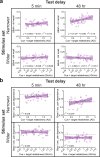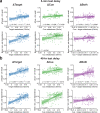Semantic relatedness retroactively boosts memory and promotes memory interdependence across episodes
- PMID: 35704025
- PMCID: PMC9203053
- DOI: 10.7554/eLife.72519
Semantic relatedness retroactively boosts memory and promotes memory interdependence across episodes
Abstract
Two fundamental issues in memory research concern when later experiences strengthen or weaken initial memories and when the two memories become linked or remain independent. A promising candidate for explaining these issues is semantic relatedness. Here, across five paired-associate learning experiments (N=1000), we systematically varied the semantic relatedness between initial and later cues, initial and later targets, or both. We found that learning retroactively benefited long-term memory performance for semantically related words (vs. unshown control words), and these benefits increased as a function of relatedness. Critically, memory dependence between initial and later pairs also increased with relatedness, suggesting that pre-existing semantic relationships promote interdependence for memories formed across episodes. We also found that modest retroactive benefits, but not interdependencies, emerged when subjects learned via studying rather than practice testing. These findings demonstrate that semantic relatedness during new learning retroactively strengthens old associations while scaffolding new ones into well-fortified memory traces.
Keywords: human; memory integration; memory reactivation; neuroscience; retroactive facilitation; retroactive interference; semantic memory.
© 2022, Antony et al.
Conflict of interest statement
JA, AR, AV, RL, RH, KB No competing interests declared
Figures















Comment in
- doi: 10.7554/elife.80030
References
-
- Anderson MC, McCulloch KC. Integration as a general boundary condition on retrieval-induced forgetting. Journal of Experimental Psychology. 1999;25:608–629. doi: 10.1037/0278-7393.25.3.608. - DOI
-
- Baddeley AD, Dale HCA. The effect of semantic similarity on retroactive interference in long- and short-term memory. Journal of Verbal Learning and Verbal Behavior. 1966;5:417–420. doi: 10.1016/S0022-5371(66)80054-3. - DOI
Publication types
MeSH terms
LinkOut - more resources
Full Text Sources

